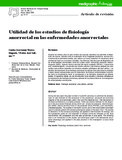| dc.rights.license | http://creativecommons.org/licenses/by-nc-sa/3.0/ve/ | |
| dc.contributor.author | Salinas, Pedro José | |
| dc.contributor.author | Torres Dugarte, Carlos Geovanny | |
| dc.date.accessioned | 2011-04-29T21:30:12Z | |
| dc.date.available | 2011-04-29T21:30:12Z | |
| dc.date.issued | 2011-04-29T21:30:12Z | |
| dc.identifier.uri | http://www.saber.ula.ve/handle/123456789/32957 | |
| dc.description | Revista Mexicana de Coloproctología Vol. 14, No. 1, Enero-Abril 2008. pp 18-28 | es_VE |
| dc.description.abstract | Durante los últimos años el gran número de avances científicos ha permitido el desarrollo
de nuevos métodos para la evaluación de la integridad anatómica, estructural y
funcional de los esfínteres anales, piso pélvico y el tracto intestinal. El mecanismo de la
continencia fecal es un proceso complejo. Hay diversos métodos para el diagnóstico de
las enfermedades anorrectales, entre los cuales están: ultrasonido endoanal, electromiografía
(EMG), latencia motora terminal del nervio pudendo (PNTML), manometría
anal, cinedefecografía. Los estudios de tránsito colónico y del intestino delgado han sido
usados para evaluar pacientes con diversos estados patológicos del piso pélvico. Los
estudios de laboratorio de la fisiología anorrectal se aplican para demostrar la etiología
y lograr planes subsecuentes para el tratamiento de diversas enfermedades funcionales
como la incontinencia fecal, la constipación y los llamados síndromes de dolores
anales. El siguiente trabajo es una introducción a los estudios y técnicas utilizadas en
los laboratorios de fisiología anorrectal y aplicada en la práctica diaria en la investigación
de enfermedades anorrectales. | es_VE |
| dc.language.iso | es | es_VE |
| dc.rights | info:eu-repo/semantics/openAccess | |
| dc.subject | Fisiología anorrectal | es_VE |
| dc.subject | Piso pélvico | es_VE |
| dc.subject | Esfínter | es_VE |
| dc.title | Utilidad de los estudios de fisiología anorrectal en las enfermedades anorrectales | es_VE |
| dc.type | info:eu-repo/semantics/article | |
| dc.description.abstract1 | During the last years the great number of scientific advances to admitted the development
of new methods for the evaluation of the anatomical, structural and functional
integrity of the anal sphincters, pelvic floor and the intestinal tract. The mechanism of
the fecal continence is a complex process. There are diverse methods for the diagnosis
of the anus-rectal illnesses among which are: ultrasound endoanal, electromyography
(EMG), latency terminal motor of the pudendal nerve (PNTML), anal manometry,
cinedefecography. The studies of the traffic colonic and of the small bowel have been
used to evaluate patient with diverse pathological states of the pelvic floor. The studies
of laboratory of the anorectal physiology are applied to demonstrate the etiology and
the subsequent plans for the treatment of diverse functional illnesses as the fecal
incontinence, the constipation and the calls syndromes of anal pains. The following
work is an introduction to the studies and techniques used in the laboratories anusrectal
physiology and applied in the daily practice in the investigation of anus-rectal
illnesses. | es_VE |
| dc.description.colacion | 18-28 | es_VE |
| dc.description.email | psalinas@ula.ve | es_VE |
| dc.description.email | carlostorres867@hotmail.com | es_VE |
| dc.publisher.pais | Venezuela | es_VE |
| dc.subject.keywords | Physiology anorectal | es_VE |
| dc.subject.keywords | Pelvic floor | es_VE |
| dc.subject.keywords | Sphincter | es_VE |
| dc.subject.thematiccategory | Medio Ambiente | es_VE |
| dc.subject.tipo | Artículos | es_VE |
| dc.type.media | Texto | es_VE |


